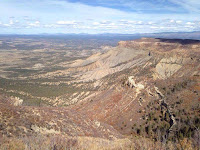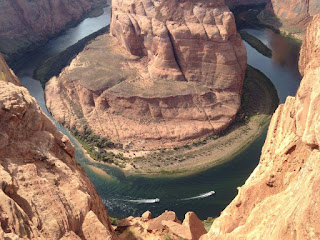We arrived in to the town of Cortez in the mid-afternoon, a smallish establishment nestled at the base of the Colorado Plateau, a rocky and mountainous region. It was these mountains that were the major reason for our visit, or more specifically the ancient Puebloan people's abandoned cliff dwellings. We checked in to our accommodation (a nice cheap Travelodge) and headed out in town for dinner. There was quite a strong Latino influence in Cortez and we chose one of the many Mexican restaurants along the Main Street - delicious!
Early the next morning we drove the 17km up to the visitors centre for the mountainous Mesa Verde National Park. Sadly due to the shift in seasons there were no longer any guided tours to the famous cliff place so instead we booked an afternoon tour to the 'Balcony House.’ We were quite lucky to be able to secure that tour as the balcony lodge tour season finishes on the 15th of October. So we had made it by 3 days!


We drove back down to Cortez to take care of a few travelling chores (laundry, etc) and then ventured in to the park itself in the early afternoon. The drive in to the park was quite long and wound itself up and down several peaks. The autumn colours really added to the beautiful forest scenery that covered the nearby hills.
There were a few lookout points along the way that gave some excellent views out over the plains below, including over Cortez itself. A few more kilometres along the road and we reached the highest point of the national park, Park Point at 2,613 metres above sea level. This point gave another great viewpoint over the surrounding area, a fact that is utilised by the local rangers who utilise the vantage point to monitor the park for wildfire.
The park has had several serious fire incidents in the past. The most recent in 2003, set off by lightning strike. Also admiring the view, was a family of local grouse, who had created a home under a picnic table.
Our pre-booked tour time was quickly approaching. So we followed the rim of the valley to the balcony house carpark. Here we joined up with the rest of our group and met our ranger who would be taking is down to the ancient dwelling.
Before setting off we were given the history of the civilisation whose former residences we would be visiting. The Puebloan people inhabited the lowlands of what is now Colorado in the approximate timeframe of 600 AD. During this time the population grew, a devastating drought set in and as a result, lands were over farmed, lakes were overfished and animals were over hunted, equalling widespread food and water shortages. These shortages led to increased tensions and finally warfare and bloodshed.
As a result, around the year 1200 AD, a small section of Puebloans left their traditional homelands on the flats and moved up into the surrounding mountains. Afraid of the violence and war, these people did not elect to build traditional villages on the peaks of the mountains, but instead, carved out whole cities right in the faces of the cliffs.


The dwelling that we were visiting were relatively small compared to the average and would have been a home to around 45 people. When inhabited the only way in and out was to scale over the valley rim and down the sheer cliff using small foot and handholds. Luckily for us a new set of stairs has been installed a couple of hundred metres south from the dwelling which led to a rocky outcrop and a short trail. Along the way the ranger continued to speak about the harsh conditions that these people faced while living here. For example the only source of water was the seepage through a small section of limestone near the cave!
This trail took us directly below the dwelling to a 10 metre ladder which we used to climb in to the balcony house itself. The cliff dwelling was something vey amazing and unique and built well enough to only require minimal restoration work to this day. It was like a tiny village or large house (though 45 people squeezed in would have been a very tight fit!) with rooms, storage vats and religious nooks all in place. Each room was surrounded by sturdy wall with accompanying windows, all jammed in to a space carved in to the cliff measuring around 6 metres at its widest and overlooking a 120 metre drop.
We passed from room to room marvelling at the conditions and workmanship that had gone in to creating this residence. It was very obvious that for people to go out of their way to create a living space like this, conditions down on the war-torn plains must have been truly terrible. Reinforcing this was the tiny crawl space that acted as a front door to the dwelling. Each of us had to get down on our hands and knees and crawl through in single file in order to exit. This would have been a great defence mechanism to aid in fighting off any hostiles attempting to access the housing.
As we crawled out of the entrance and climbed another ladder back to the cliff top, we asked the question, ‘What actually happened to the people that lived here?’ According to our guide, these cliffs were inhabited for around 80 years (3 generations in those days) and were finally abandoned around the year 1300 AD when conditions simply got too tough and a fresh start was sought out elsewhere.
We jumped back in to the car and completed the scenic loop drive of the surrounding cliffs. We got some great views across to several other cliff Dwellings including the largest, known as the 'cliff palace'. The palace was built to accommodate over 100 people, but again was suddenly abandoned at the same time as all the rest when conditions became too tough.
Along the way we were also lucky enough to spot some of the local wildlife including a couple of timid mule deer and a grazing solitary elk buck. Interestingly we had learned that the elk had been reintroduced to the area and we're now flourishing after previously haven been hunted to extinction. We made the long looping drive back to Cortez where we mixed it up by trying an Indian meal at a nearby restaurant, not bad!
The next morning we set out on a long journey that would take us all the way from Colorado, through northern Arizona and into the outskirts of Zion National Park, Utah. After roughly an hour we stopped at it first point of interest, the Four Corners Monument. This point marked the exact meeting point where the corners of four states, Colorado, Utah, Arizona and New Mexico, all meet nicely at one point. The site was located on another Indian reserve and so it required an entry fee to be paid, but it was worth it to have the opportunity to stand in four states at once!
We jumped back in the car and continued through the dry mountainous desert of Northern Arizona. We passed back along through past Antelope Canyon, which we had visited a few days before and just before entering the town of Page, we stopped at our next viewpoint, Horseshoe Bend. The carpark for Horseshoe Bend was located just off the main highway and after a kilometre long hike we reached the bend itself.
Horseshoe bend is a small section of the Colorado River (the same river that both flows through the Grand Canyon and powers the Hoover Dam) that makes a photogenic curve through the dry, red-rocked terrain of Arizona. Over millions of years the force of the water has eroded the rock, creating a magnificent and gigantic canyon that overlooks the river far below. Pleasingly from a aesthetic point of view there have been no guardrails or anything erected along the rim so the views are unspoiled. This means that tourists are free to get as close to the 300 metre drops as they wish. Some were well and truly on the precipice!
We spent a good amount of time here admiring the canyon from several different viewpoints. The weather was beautiful and the scenery was truly amazing. A few small boats wound their way along the river far below and I could only imagine the great view they would have had looking up at the canyon walls.
Once we were finished admiring the view, it was time to head back to the car and continue North, past Page, and in to Utah.
Adrian.

























😳 that was fantastic, interesting place
ReplyDeleteSure was a pretty cool place!
ReplyDelete